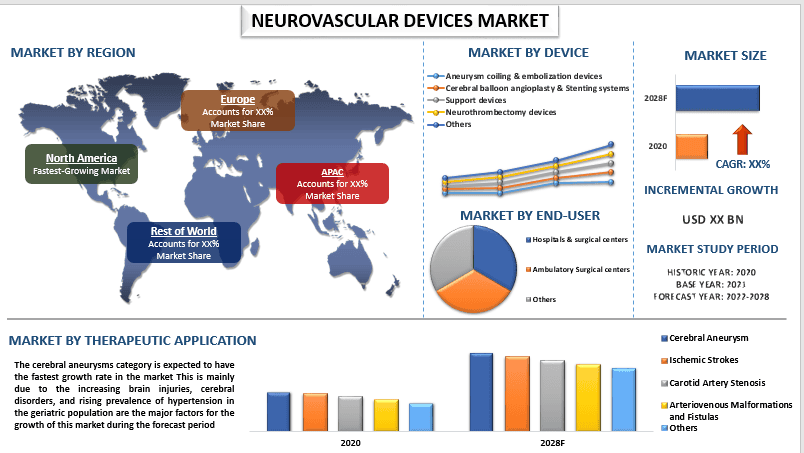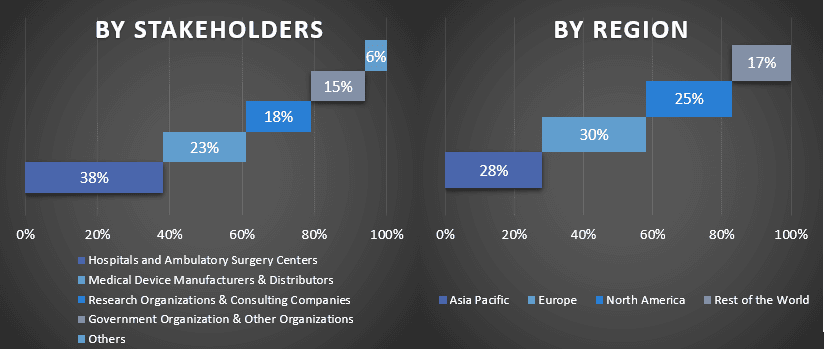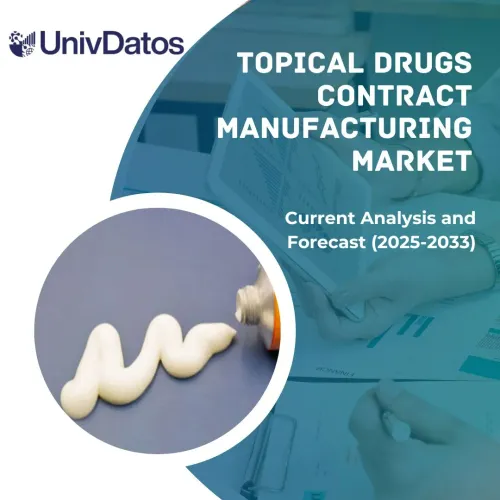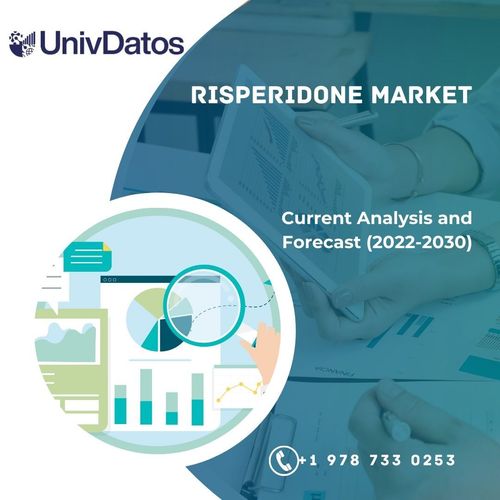- Home
- About Us
- Industry
- Services
- Reading
- Contact Us
Neurovascular Device Market: Current Analysis and Forecast (2022-2028)
Emphasis on Device (Aneurysm Coiling & Embolization Devices, Cerebral Balloon Angioplasty & Stenting Systems, Support Devices, Neurothrombectomy Devices, and Others); Therapeutic Application (Ischemic Strokes, Cerebral Aneurysm, Carotid Artery Stenosis, Arteriovenous Malformations and Fistulas, and Others); End-User (Hospitals & Surgical Centers, Ambulatory Surgical Centers, and Others); and Region/Country

The neurovascular device market has captured significant market demand and is expected to grow at a CAGR of 8% during the forecast period. Neurovascular devices are helpful in open or minimally invasive surgical procedures to treat various neurovascular diseases such as arteriovenous malformation (AVM), brain aneurysm, cerebral aneurysm, carotid artery stenosis, epilepsy, etc. For instance, according to the Brain Aneurysm Foundation, approximately 40% of ruptures result in death, and approximately 66% of those who survive have some permanent brain damage. Thus, the vast and rapidly increasing patient pool for neurovascular diseases across the world is responsible for the significant volume consumption of the neurovascular devices market during the forecast period.
Some of the major companies operating in the neurovascular device market include Stryker Corporation, Medtronic plc, Johnson & Johnson, Terumo Corporation, Penumbra Inc., Microport Scientific Corporation, Medikit co. Ltd., Integers Holding Corporation, Balt, Kaneka Corporation
Insights Presented in the Report
“Amongst device, aneurysm coiling & embolization devices category is expected to witness considerable growth during the forecast period”
Based on application, the market has been categorized into aneurysm coiling & embolization devices, cerebral balloon angioplasty & stenting systems, support devices, neurothrombectomy devices, and others. Amongst these, the aneurysm coiling & embolization devices category is expected to witness significant growth during the forecast period. This is mainly due to rising incidents of neurological diseases among the youth and major key players are looking forward to developing new technology in this sector, these factors are propelling the market growth during the forecast period. For instance, In December 2020, MicroPort Scientific Corporation received China’s National Medical Products Administration (NMPA) a registration certificate for Bridge Vertebral Drug-Eluting Stent for the treatment of symptomatic vertebral artery stenosis.
“Amongst therapeutic application, cerebral aneurysms category held a significant share in 2020”
Based on the therapeutic application, the market has been categorized into chemic strokes, cerebral aneurysms, carotid artery stenosis, arteriovenous malformations and fistulas, and others. Among these, the cerebral aneurysms category is expected to witness a significant growth rate in the neurovascular device market. This is mainly due to the rising cases of arteriovenous malformation, atherosclerosis change in mental status, numbness, weakness, and paralysis in the face or arms. These factors are the major factors for the growth of this segment during the forecast period. For instance, according to the National Organization for Rare Disorders (NORD), about 3000 new cases of arteriovenous malformation (AVM) are detected per year in the U.S.
“Amongst end-user, hospitals & surgical centers category held a significant share in 2020”
Based on end-user, the market has been categorized into hospitals & surgical centers, ambulatory surgical centers, and others. Among these, the cerebral aneurysms category is expected to witness a significant growth rate in the neurovascular device market. This is mainly due to the rising patient pool in the hospitals, and the availability of skilled healthcare professionals or equipment in the hospitals. Moreover, the large population affected by epilepsy globally is also responsible for the growth of this market. For instance, according to the World Health Organization (WHO), the global prevalence of epilepsy and multiple sclerosis was calculated at 50 million and 2.5 million respectively.
“North America to witness significant growth during the forecast period”
For a better understanding of the market, the report provides a detailed analysis of major regions and countries including North America (U.S., Canada, Rest of America); Europe (Germany, U.K., France, Spain, Italy, Rest of Europe); Asia-Pacific (China, India, Japan, Rest of Asia-Pacific) and Rest of World. In 2020, North America accounted for a significant market share. This is mainly due to the higher per capita income, higher development rate of new medical devices, and the increasing healthcare spending in the U.S. Moreover, a rising hospital administration rate of patients with mental problems and strokes every year in this region. For instance, according to the Centers for Disease Control and Prevention (CDC), every year, more than 795,000 people in the United States have a stroke. About 610,000 of these are first or new strokes.
Reasons to buy this report:
- The study includes market sizing and forecasting analysis validated by authenticated key industry experts.
- The report presents a quick review of overall industry performance at one glance.
- The report covers an in-depth analysis of prominent industry peers with a primary focus on key business financials, product portfolio, expansion strategies, and recent developments.
- Detailed examination of drivers, restraints, key trends, and opportunities prevailing in the industry.
- The study comprehensively covers the market across different segments.
- Deep dive regional level analysis of the industry.
Customization Options:
The neurovascular device market can further be customized as per the requirement or any other market segment. Besides this, UMI understands that you may have your own business needs, hence feel free to connect with us to get a report that completely suits your requirements.
Table of Content
Research Methodology for the Neurovascular Device Market Analysis (2022-2028)
Analyzing the historical market, estimation of the current market, and forecasting the future market of the neurovascular device market were the three major steps undertaken to create and analyze the adoption of neurovascular devices in major regions globally. Exhaustive secondary research was conducted to collect the historical market numbers and estimate the current market size. Secondly, to validate these insights, numerous findings and assumptions were taken into consideration. Moreover, exhaustive primary interviews were also conducted, with industry experts across the value chain of the neurovascular device market. Post assumption and validation of market numbers through primary interviews, we employed a top-down/bottom-up approach to forecasting the complete market size. Thereafter, market breakdown and data triangulation methods were adopted to estimate and analyze the market size of segments and sub-segments of the industry pertains to. Detailed methodology is explained below:
Analysis of Historical Market Size
Step 1: In-Depth Study of Secondary Sources:
Detail secondary study was conducted to obtain the historical market size of the neurovascular device market through company internal sources such as annual reports & financial statements, performance presentations, press releases, etc., and external sources including journals, news & articles, government publications, competitor publications, sector reports, third-party database, and other credible publications.
Step 2: Market Segmentation:
After obtaining the historical market size of the neurovascular device market, we conducted a detailed secondary analysis to gather historical market insights and share for different segments & sub-segments for major regions. Major segments included in the report as device, therapeutic application, and end-user. Further country-level analyses were conducted to evaluate the overall adoption of testing models in that region.
Step 3: Factor Analysis:
After acquiring the historical market size of different segments and sub-segments, we conducted a detailed factor analysis to estimate the current market size of the neurovascular device market. Further, we conducted factor analysis using dependent and independent variables such as various device, therapeutic application, and end-user of neurovascular device equipment. A thorough analysis was conducted for demand and supply-side scenarios considering top partnerships, mergers and acquisitions, business expansion, and product launches in the neurovascular device market sector across the globe.
Current Market Size Estimate & Forecast
Current Market Sizing: Based on actionable insights from the above 3 steps, we arrived at the current market size, key players in the neurovascular device market, and market shares of the segments. All the required percentage shares split, and market breakdowns were determined using the above-mentioned secondary approach and were verified through primary interviews.
Estimation & Forecasting: For market estimation and forecast, weights were assigned to different factors including drivers & trends, restraints, and opportunities available for the stakeholders. After analyzing these factors, relevant forecasting techniques i.e., the top-down/bottom-up approach were applied to arrive at the market forecast for 2028 for different segments and sub-segments across the major markets globally.
The research methodology adopted to estimate the market size encompasses:
- The industry’s market size, in terms of revenue (USD) and the adoption rate of the neurovascular device market across the major markets domestically
- All percentage shares, splits, and breakdowns of market segments and sub-segments
- Key players in the neurovascular device market in terms of solutions offered. Also, the growth strategies adopted by these players to compete in the fast-growing market
Market Size and Share Validation
Primary Research: In-depth interviews were conducted with the Key Opinion Leaders (KOLs) including Top Level Executives (CXO/VPs, Sales Head, Marketing Head, Operational Head, Regional Head, Country Head, etc.) across major regions. Primary research findings were then summarized, and statistical analysis was performed to prove the stated hypothesis. Inputs from primary research were consolidated with secondary findings, hence turning information into actionable insights.
Split of Primary Participants in Different Regions

Market Engineering
The data triangulation technique was employed to complete the overall market estimation and to arrive at precise statistical numbers for each segment and sub-segment of the neurovascular device market. Data was split into several segments & sub-segments post studying various parameters and trends in the areas of the device, therapeutic application, and end-user in the neurovascular device market.
The main objective of the Neurovascular device Market Study
The current & future market trends of the neurovascular device market were pinpointed in the study. Investors can gain strategic insights to base their discretion for investments on the qualitative and quantitative analysis performed in the study. Current and future market trends determined the overall attractiveness of the market at a regional level, providing a platform for the industrial participant to exploit the untapped market to benefit from a first-mover advantage. Other quantitative goals of the studies include:
- Analyze the current and forecast market size of the neurovascular device market in terms of value (USD). Also, analyze the current and forecast market size of different segments and sub-segments
- Segments in the study include areas of device, therapeutic application, and end-user.
- Define and analysis of the regulatory framework for the neurovascular device market industry.
- Analyze the value chain involved with the presence of various intermediaries, along with analyzing customer and competitor behaviors of the industry.
- Analyze the current and forecast market size of the neurovascular device market for the major region.
- Major countries of regions studied in the report include Asia Pacific, Europe, North America, and Rest of the world.
- Company profiles of the neurovascular device market and the growth strategies adopted by the market players to sustain in the fast-growing market
- Deep dive regional level analysis of the industry
Related Reports
Customers who bought this item also bought










